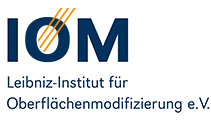Atmospheric pressure plasma jet processes are applied for generating optical freeform surfaces and correcting figure errors by using reactive gases. Plasma jet polishing, on the other hand, involves a material redistribution which is thermally driven, resulting in a reduction of surface roughness, especially at high spatial frequencies, and thus can potentially replace mechanical abrasive polishing. Current research is aimed at predicting surface morphology and roughness by analyzing the initial surface and the local effect of the plasma jet.
Recent research by scientists* in the research area Ultra-precision Surfaces / Ion beam and plasma jet based ultra-precision surface figuring“ has now demonstrated a way to predict the surface morphology of the thermally induced plasma jet polishing process. Here, the mathematical description of the local polishing effect forms the basis for the theoretical consideration of the two-dimensional polishing process. For this purpose, the topography of lapped and ground fused silica samples was measured in order to predict the polishing effect where the reduction of tool marks from pre-machining processes is also taken into account. The obtained results were compared with experimental results to establish the link between simulative process analysis and practical application in optics manufacturing.
One of the challenges in optical manufacturing is the definition of the best combination of multiple process steps with the variety of geometries up to free-form designs. By simulating and evaluating the polishing results, the form generating steps can be better adapted to the subsequent plasma jet polishing, i.e. defining suitable pre-processing conditions for e.g. grinding or laser micromachining, to make the whole process chain time and cost efficient.
The lapped and ground fused silica samples used for the investigations, were produced by the project partners at the University of Applied Sciences in Jena. This work was funded by the German Federal Ministry of Education and Research (BMBF) under the VIP+ program (No. 03VP08631) "Validation of a new process chain for the fabrication of free-form optics by plasma polishing of ultrafine ground free-form surfaces (ProFreiform)".
The results of the research have been published in the Journal of the European Optical Society-Rapid Publications. More information about the article:
H. Müller, T. Arnold
Surface morphology in plasma jet polishing: theoretical description and application
J. Eur. Opt. Society-Rapid Publ. 19 (2) 2023
https://doi.org/10.1051/jeos/2023034

